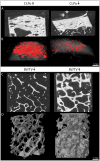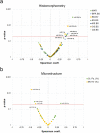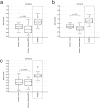Bone-related Circulating MicroRNAs miR-29b-3p, miR-550a-3p, and miR-324-3p and their Association to Bone Microstructure and Histomorphometry
- PMID: 29559644
- PMCID: PMC5861059
- DOI: 10.1038/s41598-018-22844-2
Bone-related Circulating MicroRNAs miR-29b-3p, miR-550a-3p, and miR-324-3p and their Association to Bone Microstructure and Histomorphometry
Abstract
The assessment of bone quality and the prediction of fracture risk in idiopathic osteoporosis (IOP) are complex prospects as bone mineral density (BMD) and bone turnover markers (BTM) do not indicate fracture-risk. MicroRNAs (miRNAs) are promising new biomarkers for bone diseases, but the current understanding of the biological information contained in the variability of miRNAs is limited. Here, we investigated the association between serum-levels of 19 miRNA biomarkers of idiopathic osteoporosis to bone microstructure and bone histomorphometry based upon bone biopsies and µCT (9.3 μm) scans from 36 patients. Four miRNAs were found to be correlated to bone microarchitecture and seven miRNAs to dynamic histomorphometry (p < 0.05). Three miRNAs, namely, miR-29b-3p, miR-324-3p, and miR-550a-3p showed significant correlations to histomorphometric parameters of bone formation as well as microstructure parameters. miR-29b-3p and miR-324-p were found to be reduced in patients undergoing anti-resorptive therapy. This is the first study to report that serum levels of bone-related miRNAs might be surrogates of dynamic histomorphometry and potentially reveal changes in bone microstructure. Although these findings enhance the potential value of circulating miRNAs as bone biomarkers, further experimental studies are required to qualify the clinical utility of miRNAs to reflect dynamic changes in bone formation and microstructure.
Conflict of interest statement
Roland Kocijan, Xaver Feichtinger, Patrick Heimel, Christian Muschitz, Andreas Baierl, Astrid Fahrleitner-Pammer, Heinrich Resch, Rainer Dormann, Peter Pietschmann, and Fabian Plachel state that they have no conflicts of interest. Matthias Hackl and Johannes Grillari are co-founders of TAmiRNA. Matthias Hackl, Elisabeth Geiger, and Susanna Skalicky are employed by TAmiRNA GmbH. Johannes Grillari and Heinz Redl are scientific advisors to TAmiRNA. Matthias Hackl and Johannes Grillari hold patents related to the use of circulating microRNAs as biomarkers for bone diseases.
Figures




Similar articles
-
Circulating microRNA Signatures in Patients With Idiopathic and Postmenopausal Osteoporosis and Fragility Fractures.J Clin Endocrinol Metab. 2016 Nov;101(11):4125-4134. doi: 10.1210/jc.2016-2365. Epub 2016 Aug 23. J Clin Endocrinol Metab. 2016. PMID: 27552543
-
Serum miRNAs miR-140-3p and miR-23b-3p as potential biomarkers for osteoporosis and osteoporotic fracture in postmenopausal Mexican-Mestizo women.Gene. 2018 Dec 30;679:19-27. doi: 10.1016/j.gene.2018.08.074. Epub 2018 Aug 30. Gene. 2018. PMID: 30171938
-
Serum microRNAs as novel biomarkers for osteoporotic vertebral fractures.Bone. 2020 Jan;130:115105. doi: 10.1016/j.bone.2019.115105. Epub 2019 Oct 24. Bone. 2020. PMID: 31669252
-
Circulating miRNAs: A New Opportunity in Bone Fragility.Biomolecules. 2020 Jun 18;10(6):927. doi: 10.3390/biom10060927. Biomolecules. 2020. PMID: 32570976 Free PMC article. Review.
-
Circulating MicroRNAs as Novel Biomarkers for Osteoporosis and Fragility Fracture Risk: Is There a Use in Assessment Risk?Int J Mol Sci. 2020 Sep 21;21(18):6927. doi: 10.3390/ijms21186927. Int J Mol Sci. 2020. PMID: 32967246 Free PMC article. Review.
Cited by
-
Circulating miRNAs as Potential Biomarkers in Myasthenia Gravis: Tools for Personalized Medicine.Front Immunol. 2020 Mar 4;11:213. doi: 10.3389/fimmu.2020.00213. eCollection 2020. Front Immunol. 2020. PMID: 32194544 Free PMC article. Review.
-
Extracellular Vesicle-Encapsulated miR-29b-3p Released From Bone Marrow-Derived Mesenchymal Stem Cells Underpins Osteogenic Differentiation.Front Cell Dev Biol. 2021 Jan 22;8:581545. doi: 10.3389/fcell.2020.581545. eCollection 2020. Front Cell Dev Biol. 2021. PMID: 33553139 Free PMC article.
-
Exosomal hsa_circ_0006859 is a potential biomarker for postmenopausal osteoporosis and enhances adipogenic versus osteogenic differentiation in human bone marrow mesenchymal stem cells by sponging miR-431-5p.Stem Cell Res Ther. 2021 Mar 1;12(1):157. doi: 10.1186/s13287-021-02214-y. Stem Cell Res Ther. 2021. PMID: 33648601 Free PMC article.
-
Long non-coding RNA XIST promotes osteoporosis by inhibiting the differentiation of bone marrow mesenchymal stem cell by sponging miR-29b-3p that suppresses nicotinamide N-methyltransferase.Bioengineered. 2021 Dec;12(1):6057-6069. doi: 10.1080/21655979.2021.1967711. Bioengineered. 2021. PMID: 34486487 Free PMC article.
-
Circulating microRNA plasma profile in MuSK+ myasthenia gravis.J Neuroimmunol. 2018 Dec 15;325:87-91. doi: 10.1016/j.jneuroim.2018.10.003. Epub 2018 Oct 6. J Neuroimmunol. 2018. PMID: 30316681 Free PMC article.
References
-
- Heshmati HM, Khosla S. Idiopathic osteoporosis: a heterogeneous entity. Ann Med Interne (Paris) 1998;149:77–81. - PubMed
Publication types
MeSH terms
Substances
LinkOut - more resources
Full Text Sources
Other Literature Sources
Medical

